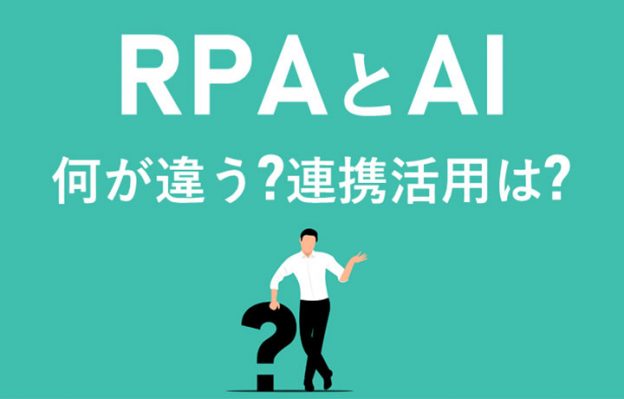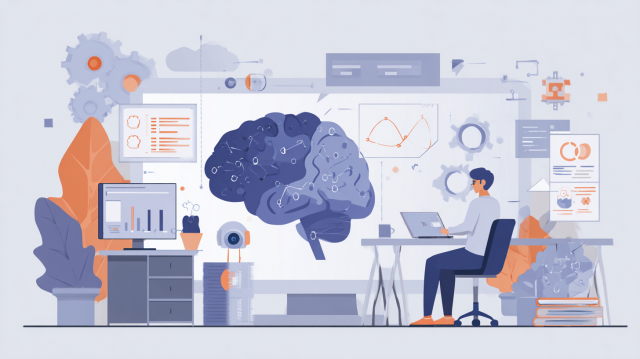
RPA is a term that is often seen alongside AI as a method for business improvement and efficiency.
In this article,
we will explain the basics of RPA and its differences from AI for those who are wondering,
"What is RPA?"
"I don't understand how it differs from AI"
"I don't know what kind of applications there are." We will also introduce examples of how RPA and AI can be used together.
- Table of Contents
-
- 1. The Difference Between RPA and AI
- 1-1. What is RPA?
- 1-2. What is AI?
- 1-3. Differences between RPA and AI
- 1-4. Background of the Growing Attention on RPA
- 1-5. Benefits of RPA Implementation
- 2. Types of RPA Tools
- 2-1. Desktop (On-Premises)
- 2-2. Server Type (On-Premises)
- 2-3. Cloud-based
- 3. How to Utilize RPA
- 3-1. Data and Text Input and Transcription
- 3-2. Comparison and Verification of Information
- 3-3. Monitoring
- 4. Three Classes of RPA
- 4-1. Class 1: RPA (Robotic Process Automation)
- 4-2. Class 2: EPA (Enhanced Process Automation)
- 4-3. Class 3: CA (Cognitive Automation)
- 5. Future Evolution
- 5-1. Recommended Tools
- 6. Use Cases of Integrating RPA and AI
- 6-1. Digitization of Paper Documents in Local Governments
- 6-2. Combination of AI Decision-Making and RPA for Routine Tasks
- 7. For inquiries about AI utilization, contact Human Science
- 7-1. Achievements of 48 million teacher data created
- 7-2. Resource Management Without Using Crowdsourcing
- 7-3. Utilizing the latest data annotation tools
- 7-4. Complete Security Room in Our Company
1. The Difference Between RPA and AI

We will look at the differences starting from the overview of RPA and AI.
1-1. What is RPA?
RPA stands for Robotic Process Automation. It refers to the automation of business processes by robots. The business processes mentioned here are routine tasks such as data entry, transcription, and file duplication or movement performed on a computer. The robot executes the same operations on the screen as a human would. To operate RPA, it is necessary for a human to first specify the tasks they want the robot to perform and have RPA record those tasks.
1-2. What is AI?
AI stands for Artificial Intelligence. It refers to the artificial intelligence itself. AI can make decisions on its own for the given tasks. Prior machine learning is required to operate AI. By providing training data known as teacher data, AI can discover features and patterns from it and acquire decision-making abilities.
1-3. Differences between RPA and AI
The decisive difference between RPA and AI is whether the system can make judgments on its own. RPA only executes what has been specified by humans. It cannot do more than that. On the other hand, AI can perform tasks based on its own judgments, which are derived from prior learning.
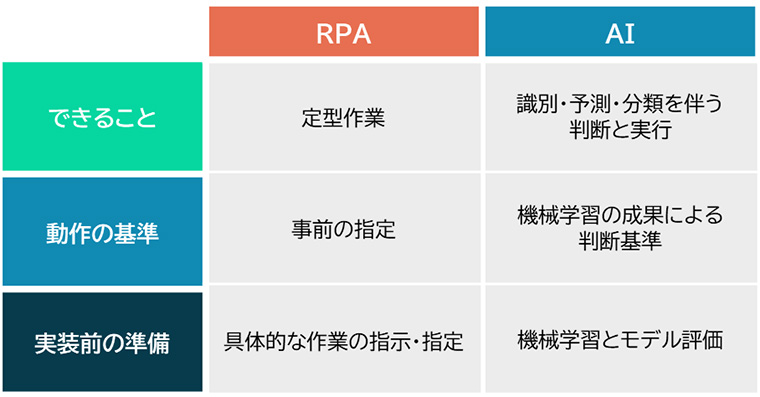
Please also refer to this article about AI machine learning and teacher data.
>>What is teacher data? Explanation from the relationship with AI, machine learning, and annotation to how to create it.
1-4. Background of the Growing Attention on RPA
The reasons RPA is gaining attention are "solving the labor shortage" and "improving operational efficiency." Japan is experiencing a declining birthrate and an aging population, leading to a decrease in the labor force across various industries, which has become a social issue. The shortage of personnel in the IT industry, in particular, is serious.
According to the "Survey on IT Human Resource Supply and Demand" announced by the Ministry of Economy, Trade and Industry in March 2019, it is said that there will be a shortage of up to approximately 790,000 IT professionals by 2030. By assigning part of the work to RPA, the effective utilization of human resources has become a focus. RPA is gaining attention as a tool that can solve chronic labor shortages and improve operational efficiency.
1-5. Benefits of RPA Implementation
RPA can take over tasks that have traditionally been performed by humans, providing the benefit of improving operational efficiency through its implementation. Many RPA tools can be configured using operations like drag-and-drop, so advanced programming knowledge is not required. This ease of implementation is believed to significantly reduce the training time, which is often a challenge in human resource development.
By utilizing the time saved through the automation of existing operations, it becomes possible to allocate time to creative tasks such as sales and planning. RPA is suitable for automating mechanical tasks, but in recent years, versions equipped with AI have also emerged.
2. Types of RPA Tools

There are three main types of tools for implementing RPA.
2-1. Desktop (On-Premises)
This is how to install tools on each machine that wants to use RPA. It is suitable for those who want to start small while keeping initial costs down.
2-2. Server Type (On-Premises)
This is how to install RPA tools on on-premises servers and client machines. You can manage the tools for each machine from the server side. Large-scale operations are also possible.
2-3. Cloud-based
This is how to use the RPA system installed on the provider's server online. It can accommodate remote operations while keeping costs down.
3. How to Utilize RPA

RPA can handle simple tasks and routine operations. Tasks that follow established rules and repetitive work are the areas where RPA excels. Here are some typical use cases.
3-1. Data and Text Input and Transcription
You can automatically input data and text in browsers and spreadsheets. It is also possible to transfer data across tools, such as copying data from a browser to a spreadsheet. This allows for fast processing without the worry of transcription errors.
Example: Transferring the contents of a contact form to a spreadsheet.
3-2. Comparison and Verification of Information
You can collect information from multiple applications and compare and verify the content. Here are some examples.
Example: Automatically generate a report that aggregates information on a regular basis.
3-3. Monitoring
You can monitor the status of systems and other elements at fixed points. This reduces the need for human checks and leads to rapid responses in the event of anomalies.
Example: Monitor system data and send an email to the person in charge if there is unusual activity.
4. Three Classes of RPA
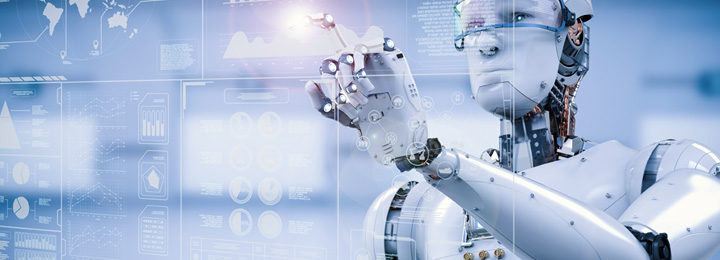
There are three classes of RPA.
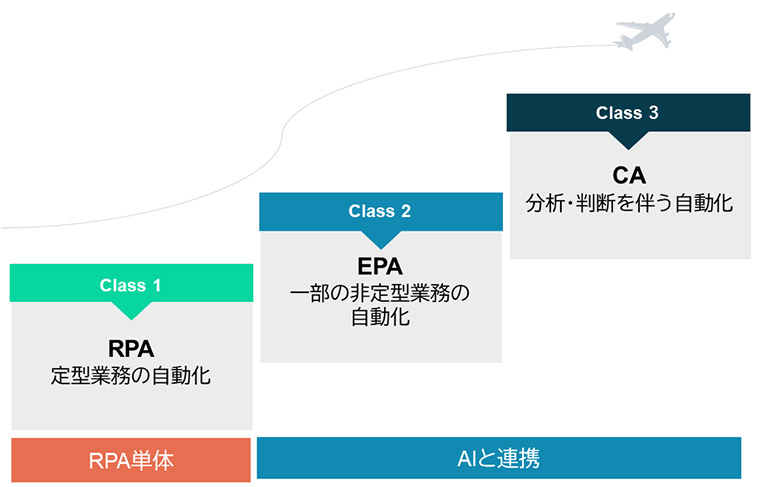
4-1. Class 1: RPA (Robotic Process Automation)
The conventional RPA explained above falls under Class 1. It is suitable for automating routine tasks. It is difficult to handle exceptional situations.
4-2. Class 2: EPA (Enhanced Process Automation)
By collaborating with AI, we can handle a certain degree of non-standard tasks. We can also accommodate some exceptional situations.
4-3. Class 3: CA (Cognitive Automation)
Higher level of automation. By collaborating with advanced AI, it becomes possible for the robot itself to analyze data and construct workflows suited to the tasks.
5. Future Evolution through RPA Implementation
Tasks such as creating invoices and customer lists, which involve merely transcribing information, can be entrusted to RPA. In the future, the variety of RPA will increase, broadening its applications. After the introduction of RPA, labor costs can be significantly reduced, allowing the costs and time previously allocated to labor, as mentioned earlier, to be redirected to creative activities that cannot be automated.
However, tasks such as reading text from handwritten images are difficult for RPA, and the intervention of AI technology is necessary for automation. It is said that RPA equipped with AI (artificial intelligence) will become widespread in the future. With the combination of AI technology, tasks that were difficult to automate with traditional RPA will also be automated.
5-1. Recommended RPA Tools
We will introduce recommended RPA tools for utilizing RPA in your business.
1. Automation 360 | Automation Anywhere (Hitachi Solutions)
"Automation 360" is the latest RPA platform provided by Automation Anywhere, sold by Hitachi Solutions, and supported by user technical support. It is available in both cloud-based and on-premises versions, and the appeal lies in the fact that it can be implemented without significantly changing the company's environment, as it can be used through a browser.
It is certified for hosting with Microsoft Azure and Google Cloud, and has scalability that matches the growth of businesses. The system incorporates AI technology, enabling automation of tasks regardless of the user's skill level.
The learning service "Automation Anywhere University" offers various video content for learning about development, operations, and more.
>>RPA Business Automation Solution Automation 360
WinActor | NTT Business Solutions
"WinActor" is an RPA solution provided by NTT Advanced Technology. It has gained attention as a purely domestic RPA tool developed by the NTT Group.
It is possible to create scenarios for automation through drag-and-drop operations. Since it supports all software that can be operated from Windows devices, such as email, browsers, and Microsoft Office products, it enables business efficiency improvements.
It can be utilized for automating various tasks, regardless of job type or department, such as report creation, web research, communication, and transcription work.
6. Use Cases of Integrating RPA and AI

By combining the strengths of RPA and AI, you can achieve greater operational efficiency than implementing them individually. Here, we will introduce examples of how AI and RPA can be utilized together.
6-1. Digitization of Paper Documents in Local Governments
In a certain municipality, when registering the contents of paper documents into the system, the process was previously handled by staff through visual confirmation and manual input. During peak times when applications such as tax declarations and residency transfers are concentrated, staff would become fully occupied with that task, leading to the decision to verify the effectiveness of business improvement through automation.
- Methods of Automation
AI OCR automates the reading of text information. It extracts text areas from scanned images of documents using AI OCR and converts the content, including handwritten characters, into data that can be utilized on a computer. Subsequently, RPA automatically performs the transcription and registration into the system.
・Effect
The results of the verification showed that this automation is expected to reduce labor hours by 1,400 hours annually.
>>We conducted a verification of business automation utilizing AI-OCR and RPA
6-2. Combination of AI Decision-Making and RPA for Routine Tasks
The AI OCR introduced in this case can predict and determine the content even for difficult-to-read handwritten characters. The surrounding characters and previously learned data serve as the basis for this judgment. By combining the unique predictions and judgments of AI with the rapid automated input tasks of RPA, significant improvements in operational efficiency can be expected.
7. For inquiries about AI utilization, contact Human Science
7-1. Achievements of 48 million teacher data created
"I want to implement AI, but I don’t know where to start."
"I don’t know what to request, even if I outsource."
If your company is struggling with either of these issues, please feel free to contact Human Science. Our company has been involved in AI model development projects across various industries, starting with natural language processing and extending to medical support, automobiles, IT, manufacturing, and construction, just to name a few. Through direct business with many companies, including GAFAM, we have provided over 48 million pieces of high-quality training data. No matter the industry, our team is prepared to handle anything from small-scale annotation projects to long-term ventures with 150 annotators.
>> Human Science’s Annotation Services
7-2. Resource Management Without Using Crowdsourcing
At Human Science, we do not use crowdsourcing. Instead, projects are handled by personnel who are contracted with us directly. Based on a solid understanding of each member's practical experience and their evaluations from previous projects, we form teams that can deliver maximum performance.
7-3. Utilizing the latest data annotation tools
One of the annotation tools introduced by Human Science is AnnoFab, which lets you receive progress checks and customer feedback on the cloud, even while the project is ongoing. By ensuring that work data cannot be saved on local machines, we demonstrate appropriate security measures.
7-4. Complete Security Room in Our Company
Human Science has a secure room that meets ISMS standards within our Shinjuku office, so we can handle even highly confidential projects on-site. The promise of of confidentiality is extremely important to us for any of our projects. We provide continuous security training to our staff, and we handle all information and data with the utmost care, even on remote projects.

 Text Annotation
Text Annotation Audio Annotation
Audio Annotation Image & Video Annotation
Image & Video Annotation Generative AI, LLM, RAG Data Structuring
Generative AI, LLM, RAG Data Structuring
 AI Model Development
AI Model Development In-House Support
In-House Support For the medical industry
For the medical industry For the automotive industry
For the automotive industry For the IT industry
For the IT industry